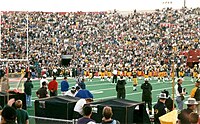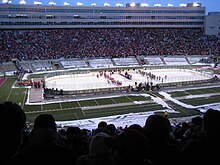Camp Randall Stadium
It has been the home of the Wisconsin Badgers football team in rudimentary form since 1895, and as a fully functioning stadium since 1917.
After an outcry from veterans over plans to turn the site into building lots, the state bought it in 1893 and presented it to the university.
It consisted of 7,500 concrete seats—roughly corresponding to the lower portion of the current stadium's east grandstand—and 3,000 wooden seats from the old field.
In 1940, the UW built an addition to the east side of Camp Randall that included housing for 150 people (as well as a rifle range and facilities for boxing and wrestling).
In addition, concessions, restrooms and other infrastructure items were upgraded, the walkway around the field was removed, and new scoreboards were installed.
decided that the color may irritate the opposing team and had the room painted a pale shade of blue called "prison blue", named for the shade of paint used in Wisconsin Department of Corrections facility cells, which is intended to have a "calming effect."
The numbers of Wisconsin's two Heisman Trophy winners, Alan Ameche and Ron Dayne, are displayed on the upper deck façade.
[13] At Barry Alvarez's final game as head coach in 2005, plans were announced to place a statue of him in the Stadium's Kellner Plaza.
[14] Announced in the fall of 2010 and completed in January 2014, the Student Athlete Performance Center, an expansion of Camp Randall to the north, included a new scoreboard, academic and strength training facilities, multimedia instructional space, lower-level football team access tunnel, and renovated locker rooms, shower rooms and equipment space.
Some of these include: In 1969, the Badgers had lost 24 straight games, and Michael Leckrone took over the Wisconsin Marching Band.
Working with athletic director Elroy Hirsch, Leckrone and the band created a fan event called "The Fifth Quarter", that took place at the end of the game.
Songs typically played during the Fifth Quarter include "On Wisconsin", "You've Said It All" (also known as the "Bud" song, referring to its beginning as a jingle in a Budweiser beer commercial), "Space Badgers" (A variation on the opening to Also sprach Zarathustra), "Dance Little Bird" (The Chicken Dance), "Beer Barrel Polka", "Tequila", and "Hey Baby."
[23] Another tradition at UW football games is the "Jump Around", where fans dance to the House of Pain song of the same name.
The tradition began during the 1993 football season with the men's swim team smuggling in a megaphone and discman and playing the song to rile up sections O and P. The media start was on Saturday, October 10, 1998, at the Badgers' Homecoming game against the Purdue Boilermakers.
[24] After no offensive points were scored in the third quarter, the Badgers' marketing agent in charge of sound piped the song through the loudspeakers.
On September 6, 2003, (the Badgers' first home game of the season), with construction of the skyboxes surrounding the stadium, UW officials decided to cancel the "Jump Around" tradition that had been a staple for five years.
When news surfaced on Monday, September 8, 2003, that this event was not a technical or human malfunction, but rather a decision by campus officials, the students launched a protest.
The Camp Randall athletic complex includes three additional facilities: the Field House, home to the UW basketball teams until January 1998, and now the wrestling and women's volleyball teams; the Dave McClain Athletic Facility, an indoor football practice facility named for the late Badgers football coach, Dave McClain, which also houses locker rooms for football, men's and women's track, and soccer, and strength and conditioning, sports medicine, and academic services; and the Camp Randall Memorial Sports Center ("The Shell"), which contains a 200-meter indoor track that surrounds facilities for intramural sports.

prior to stadium construction




